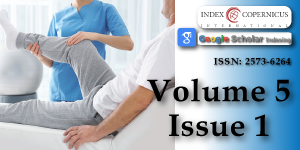FITT-CORRECT: Updated dynamic and evidence-based principle of exercise prescription
Main Article Content
Abstract
Objective: The FITT (Frequency, Intensity, Time, and Type) principle is an effective foundation in EP. However, the CORRECT components; C–Combination of interventions, O–Order of the Interventions, R–Repetitions, R–Rest period between sets and between sessions, E–Exercise at home, C–Cognitive domain, T–Total dose and re-evaluation plans, should be considered. The purpose of this paper was to describe the updated dynamic and evidence based FITT-CORRECT principle of EP and demonstrates its application using a case study.
Results: Literatures, related to EP, clinical reasoning and clinical decision-making, were critically reviewed. Established evidence is summarized to describe an updated dynamic and evidence-based principle of EP. The gaps within the FITT and other related principles of EP are addressed. The FITT-CORRECT principle was introduced and an effective outcome of the updated principle was demonstrated using a case study. The FITT-CORRECT principle integrates many components that are missing in the FITT and other related EP principles. Based on the reported case study, the FITT-CORRECT principle of EP should optimize patients’ intervention outcomes. Physiotherapists can potentially improve their EP by utilizing the FITT-CORRECT in clinical practice.
Article Details
Copyright (c) 2021 Adhikari SP, et al.

This work is licensed under a Creative Commons Attribution 4.0 International License.
Riebe D. editor. General Principles of EP ACSM's Guidelines for Exercise Testing and Prescription. 9th ed: Wolters Kluwer/Lippincott Williams & Wilkins; 2014. PubMed: https://www.ncbi.nlm.nih.gov/pmc/articles/PMC4139760/
ACSM, editor. Guidelines for exercise testing and prescription. 8th ed: Philadelphia: Lippincott Williams & Wilkins; ; 2010.
Reid RER, Thivel D, Mathieu ME. Understanding the Potential Contribution of a Third "T" to FITT EP: The Case of Timing in Exercise for Obesity and Cardiometabolic Management in Children. Appl Physiol Nutr Metab. 2019.
Ranasinghe C, King NA, Arena R, Hills AP. FITTSBALL - a dynamic tool for supervision of clinical EP. Disabil Rehabil. 2019: 41: 3216-3226. PubMed: https://pubmed.ncbi.nlm.nih.gov/30053786/
Billinger SA, Boyne P, Coughenour E, Dunning K, Mattlage A. Does aerobic exercise and the FITT principle fit into stroke recovery? Curr Neurol Neurosci Rep. 2015; 15: 519. PubMed: https://pubmed.ncbi.nlm.nih.gov/25475494/
Winstein C, Lewthwaite R, Blanton SR, Wolf LB, Wishart L. Infusing motor learning research into neurorehabilitation practice: a historical perspective with case exemplar from the accelerated skill acquisition program. J Neurol Phys Ther. 2014; 38: 190-200. PubMed: https://pubmed.ncbi.nlm.nih.gov/24828523/
Adhikari SP, Tretriluxana J, Chaiyawat P, Jalayondeja C. Enhanced Upper Extremity Functions with a Single Session of Action-Observation-Execution and Accelerated Skill Acquisition Program in Subacute Stroke. Stroke Res Treat. 2018; 2018: 1490692.
Inoue DS, Panissa VL, Monteiro PA, Gerosa-Neto J, Rossi FE, et al. Immunometabolic Responses to Concurrent Training: The Effects of Exercise Order in Recreational Weightlifters. J Strength Cond Res. 2016; 30: 1960-1967. PubMed: https://pubmed.ncbi.nlm.nih.gov/26626027/
Jones TW, Howatson G, Russell M, French DN. Effects of strength and endurance exercise order on endocrine responses to concurrent training. Eur J Sport Sci. 2017;17: 326-334. PubMed: https://pubmed.ncbi.nlm.nih.gov/27817246/
Stoykov ME, Madhavan S. Motor priming in neurorehabilitation. J Neurol Phys Ther. 2015; 39: 33-42. PubMed: https://pubmed.ncbi.nlm.nih.gov/25415551/
Nedelko V, Hassa T, Hamzei F, Weiller C, Binkofski F, et al. Age-independent activation in areas of the mirror neuron system during action observation and action imagery. A fMRI study. Restor Neurol Neurosci. 2010; 28: 737-747. PubMed: https://pubmed.ncbi.nlm.nih.gov/21209489/
Celnik P, Webster B, Glasser DM, Cohen LG. Effects of action observation on physical training after stroke. Stroke. 2008; 39: 1814-1820. PubMed: https://pubmed.ncbi.nlm.nih.gov/18403746/
Simao R, Figueiredo T, Leite RD, Jansen A, Willardson JM. Influence of exercise order on repetition performance during low-intensity resistance exercise. Res Sports Med. 2012; 20: 263-273. PubMed: https://pubmed.ncbi.nlm.nih.gov/22742079/
Simao R, de Salles BF, Figueiredo T, Dias I, Willardson JM. Exercise order in resistance training. Sports Med. 2012; 42: 251-265. PubMed: https://pubmed.ncbi.nlm.nih.gov/22292516/
Kleim JA, Jones TA. Principles of experience-dependent neural plasticity: implications for rehabilitation after brain damage. J Speech Lang Hear Res. 2008; 51: S225-239. PubMed: https://pubmed.ncbi.nlm.nih.gov/18230848/
Szalewska D, Zielinski P, Tomaszewski J, Kusiak-Kaczmarek M, Lepska L, et al. Effects of outpatient followed by home-based telemonitored cardiac rehabilitation in patients with coronary artery disease. Kardiol Pol. 2015; 73: 1101-1107. PubMed: https://pubmed.ncbi.nlm.nih.gov/25987401/
Williams MA, Haskell WL, Ades PA, Amsterdam EA, Bittner V, et al. Resistance exercise in individuals with and without cardiovascular disease: 2007 update: a scientific statement from the American Heart Association Council on Clinical Cardiology and Council on Nutrition, Physical Activity, and Metabolism. Circulation. 2007; 116: 572-584. PubMed: https://pubmed.ncbi.nlm.nih.gov/17638929/
Brody LT. Effective therapeutic EP: the right exercise at the right dose. J Hand Ther. 2012; 25: 220-231.
Young JL, Rhon DI, de Zoete RMJ, Cleland JA, Snodgrass SJ. The influence of dosing on effect size of exercise therapy for musculoskeletal foot and ankle disorders: a systematic review. Braz J Phys Ther. 2018; 22: 20-32. PubMed: https://pubmed.ncbi.nlm.nih.gov/29157736/
Young JL, Rhon DI, Cleland JA, Snodgrass SJ. The Influence of Exercise Dosing on Outcomes in Patients With Knee Disorders: A Systematic Review. J Orthop Sports Phys Ther. 2018; 48: 146-161. PubMed: https://pubmed.ncbi.nlm.nih.gov/29320945/

